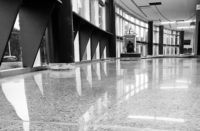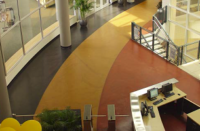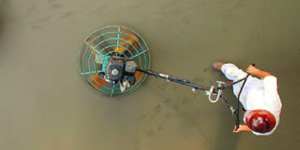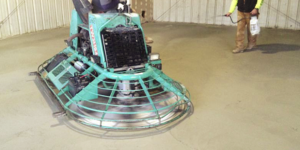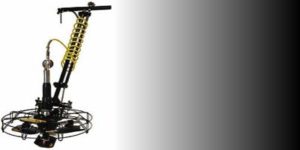Beauty may only be skin deep, but the performance qualities of an MQ Whiteman SlabArmor concrete surface are just as impressive as the strikingly good looks the SlabArmor system delivers.
That’s the bold assertion submitted by the developer of the SlabArmor technology — Multiquip Inc./Whiteman, or just MQ Whiteman — and Eric Traffie, a Wilton, New Hampshire-based concrete contractor who has jumped wholeheartedly on the patented process.
“It’s different than anything before it,” says Ben Wiese, product manager and application specialist for Multiquip’s Concrete Solutions business.
“SlabArmor helps prevent curling and cracking,” says Traffie, of Premier Concrete Construction LLC, a Bomanite partner. “It’s high-tech concrete. If your timing is good, it provides workability. It’s more stain resistant. It’s a new technology that I believe will become common very soon. There’s considerable benefit at fairly low cost.”
Tender project
Employing Multiquip’s SlabArmor process, Premier Concrete recently executed a major concrete-installation project — construction of a 140,000-square-foot floor for a New Hampshire company, Tender Corp., a marketer of outdoor survival kits, insect bite treatments and related items. The concrete project consisted of 40,000 square feet on the building’s slab-on-deck mezzanine level, and 100,000 square feet on the slab-on-grade ground level.
SlabArmor is a trowel-in cure product applied during the concrete finishing process. It’s a patented formulation of nano-sized silica particles reported to penetrate the concrete up to 1.06 inches and fill air voids and close capillaries created during the pour and the hydration process.
The process minimizes volume loss, cracking and curling, while allowing only 3 percent of the water to escape from the concrete. It extends material life by reducing surface abrasion and creating a sustainable surface profile.
Traffie says Premier had done a number of concrete installations for the building owner at other locations, and the owner agreed to use the SlabArmor process for this project rather than employing a densification/polishing program.
But Wiese emphasizes that the process shouldn’t be considered simply a lower-cost alternative to hardening and polishing. In fact, he envisions a significant market for the process within the polished-concrete segment to provide a better canvas for the polishing process to start from, in addition to horizontal concrete installations in general.
Timing is paramount
The SlabArmor process adds a couple of steps to a standard installation. “You’re not changing the finishing process, and it doesn’t change any of your best practices,” Wiese says. Used upfront in the concrete-installation sequence of steps, he adds, the process enhances the performance and aesthetics of a hardening/polishing job.
After the concrete has been placed but prior to bull floating, the first of three applications of a SlabArmor formula called Starter is applied to the wet concrete and allowed to activate. This closes the capillaries in the slab, retaining 97 percent of the water in the concrete.
Two additional coats are applied during the power-trowel phase of the job. Here, the formula acts as a finishing aid, retaining water in the concrete and producing an easily workable, densely consolidated and highly refined surface.
Timing is everything, the saying goes, and with SlabArmor it’s not just cliche — it’s crucial. The contractor must “read” the pour, making sure the SlabArmor Starter is applied before bull floating and during or after the first and second pan.
After the finishing process is completed, the SlabArmor formula Closer is applied. This is a nonfilm-forming, hydrophobic fixative that crosslinks with the Starter formula to produce a higher level of initial hardness. It also dustproofs the surface.
An optional step involving SlabArmor Seal & Shine is taken if specifications call for a reflective surface without grinding and polishing. Multiquip recommends this optional step be done just before the space is occupied, otherwise construction activity and traffic would require either touching up the surface or repeating the process.
According to Multiquip, Seal & Shine improves sheen, hardness and chemical resistance. It also provides a high-gloss, stain- and wear-resistant finish by forming an insoluble chemical bond that produces a dense, sealed surface. The company describes it as resistant to blushing, and writes it does not yellow, chip, peel or flake with age and exposure.
High-tech concrete
Traffie says he was sold on SlabArmor after giving it a test run on a sample area in the Premier Concrete shop, then using the process on a couple of small projects of 1,000 square feet or so. “We wanted to get the feel for it,” he says.
The benefits were quickly apparent — absence of curling or cracking, stain resistance, rapid cure. He considers the attractive, polished-looking appearance a “side benefit.”
The process, which he refers to as “the next level” for concrete installation methodology, also has economics on its side. “On this job, the placing costs were higher, but the polishing part would have been much higher” if a complete densification/polishing protocol were used. “There’s more labor in the concrete installation, but considerably less after that.”
Traffie characterizes the owner’s reaction to the results as “ecstatic.”
In it for the long term
MQ Whiteman, for 78 years a well-regarded supplier of equipment used for concrete placing and finishing, moved beyond business as usual into technology and process innovation by collaborating with Multiquip to develop SlabArmor. An initial commercial-scale installation in 2011 followed several years of R&D and experimentation. The formal introduction of the system came at World of Concrete 2014 in Las Vegas.
“The development process was long and tedious,” Wiese says. “We have a responsibility to the [Whiteman] brand not to sully ourselves. We needed to make it as bulletproof as possible.”
In keeping with that tendency toward understatement, Wiese is hesitant to trumpet the SlabArmor process as the greatest, most revolutionary sensation in concrete since Roman times. No Billy Mays/OxiClean-commercial decibel levels here. The process is billed not as a new and improved alternative to grinding and polishing or another treatment, but as an enhancement to the art and science of concrete installation and finishing that can enhance slab quality and appearance and results of those additional treatments.
“The aesthetics are one benefit,” Wiese says. “But the real benefit is sustainability of the slab — long-term performance.”
Project at a Glance
Client: Tender Corp., Littleton, New Hampshire
Concrete contractor: Premier Concrete Construction LLC, Wilton, New Hampshire
www.premierconcretellc.com
General contractor: Daniel Hebert Inc., Colebrook, New Hampshire
www.dhigc.com
Scope of project: Install 140,000-square-foot concrete flooring (slab on deck and slab on grade), incorporating SlabArmor system and products. www.mqslabarmor.com
Project duration: Two weeks for concrete placement; 1.5 weeks for final clean/seal
Most challenging aspects: Cold temperatures inside insulated-panel building, placement layout, working around other trades
Products used: Redimix Cos. Inc. (concrete mix); SlabArmor Starter and Closer, concrete conditioner and Seal & Shine; Acrylicon Flake (in clean-room areas); Somero Laser Screed; two Allen Razorback SP400 riding trowels; Whiteman HHN and HHX riding trowels; Soff-cut saws; Tennant T16 rider scrubber; Silex diamonds; Lavina 32R-S grinder and Pioneer Eclipse burnishers

